| 1 | India’s hidden forest killer |
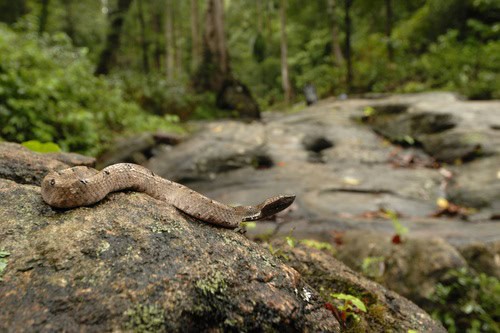
India is the land with a venomous snake for every conceivable location. Russell’s vipers lurk between crop field rows, Indian cobras slither openly through rural villages, while saw-scaled vipers hide below piles of coconut husks in dry areas. The Indian snake most likely to appear on leafy forest floors is the hump-nosed pitviper (Hypnale hypnale), a species ranging from 40-55cm with a maximum of 60cm.
This snake inhabits southwest India, as well as Sri Lanka. Its main home is the damp, hilly Western Ghats mountain range, which peak at 2695 metres, and are an official Unesco World heritage site due to the explosion of biodiversity they possess.
This species is much more dangerous than once believed. Its venom lacks neurotoxins, but is haemorrhagic and damaging to the kidneys, and capable of causing fatalities. Hump-nosed pitvipers are a big threat to rubber plantation workers, during their morning latex harvests, and are believed to top the tables for annual snakebites in Sri Lanka. Hypnale hypnale also has a late onset of symptoms, as it can take 12 hours for the coagulopathy to manifest in human victims.
| 2 | Blends perfectly with leaf litter |
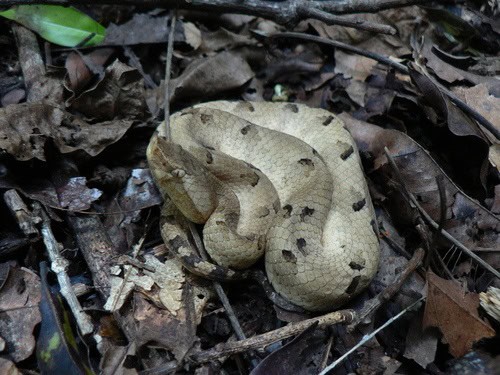
Hump-nosed pitvipers are nearly always found in forests, including evergreen forests, coffee plantations and areas rich in bamboo. In the western Ghats, hump-nosed pitvipers have a venomous neighbour they constantly share these forests with – the Malabar pitviper, one of Earth’s most variable snakes in colour. It’s possible to find multiple members within one forest hollow.
How do they coexist without outcompeting each other? The answer is simple – Malabar pitvipers spend virtually all their lives on tree branches, while hump-nosed pitvipers stick to the forest floor. The most they climb is into low bushes, or onto rotting logs by water bodies, which are a particular favourite.
Hump-nosed pitvipers are usually found on a thick bed of leaf litter, and their camouflage is optimised for this, as well as the murky brown-black soil of the forest. Hump-nosed pitvipers can lie for hours or days in tight coil formation.
Hump-nosed pitvipers are significantly deadlier than their colourful, tree-bound neighbour. According to a 2023 study, the LD50 venom toxicity rating of Hypnale hypnale was 1.32mg, easily defeating the Malabar pitviper at 6mg.
| 3 | Small and easy to miss |
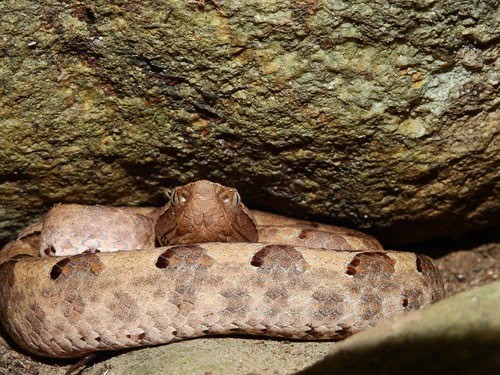
Hump-nosed pitvipers have keeled scales to touch, rather than smooth, and a sharply triangular head. This is one of India’s smallest dangerously venomous snakes. For example, a survey of 19 hump-nosed pitvipers in India’s Goa state found a range of 41-46cm.
The name originates from its upturned snout, which is easy to see from a side view, though trickier if you’re standing above. It’s possible this nose has a connection to leaf litter, allowing it to rummage through the fallen foliage.
Lurking on leaf litter is also connected to their diet. A layer of leaves 20-50cm thick can hold an entire mini civilisation of skinks, small frogs and small toads, particularly in the swarming western Ghats hill forests. Hypnale hypnale feeds on these prey, luring them out of the very comfortable bed it is sitting on.
It’s thought that mammals only comprise a small portion of Hypnale hypnale’s diet. Another lurking place is within the roots of shrubs. This snake isn’t hard to find – an average Joe on a weekend hill exploration could bump into (and be bitten by) the hump-nosed pitviper within minutes.
| 4 | Deadlier than once believed |
Officially, Hypnale hypnale isn’t part of India’s big 4 snakes, yet in certain regions of southwest India it outstrips them for bites. One report covered 1500 hospital patients from Kerala state, which includes a large portion of the hilly western Ghats. These bites occurred from January 2012 to October 2016.
At 538, Russell’s vipers dominated the bite statistics, just as they dominate India overall. But hump-nosed pitvipers came in a surprising 3rd place, at 224 bites, just behind the Indian krait at 382 bites.
The report revealed why you should always tread carefully in any forest known to contain hump-nosed pitvipers, or indeed tread carefully anywhere in the western Ghats. With 224 bites, the authors were able to provide an extremely detailed breakdown of symptoms. Local pain affected 93.3% of Hypnale hypnale victims, local swelling 91%, and bleeding from the bite site 91.9%. These are the baseline viper symptoms. The percentage experiencing coagulopathy, essentially any form of blood clotting disruption (not necessarily appearing as haemorrhaging) was a staggering 97.7%…
| 5 | Targets the kidneys |
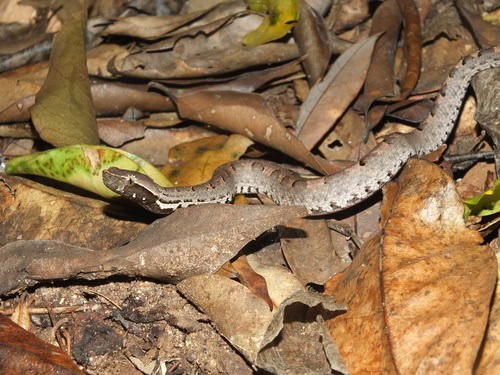
Vomiting was a relatively common systemic symptom, affecting 40.6% of hump-nosed pitviper victims. 58.4% experienced “Systemic bleeding manifestations”, AKA haemorrhaging. 19.6% suffered acute kidney injury, and 6.6% suffered kidney injury severe enough to require dialysis. As they contain few neurotoxins, hump-nosed pitvipers go easy on the lungs, but laser in on the kidneys.
Finally, hump-nosed pitvipers were the worst species of all for gangrene, necrosis and cellulitis. This affected 36.16% of patients, easily beating the infamous Russell’s viper (19.5%). This is surprising given how farm workers bitten by Russell’s vipers lurking between the crops often require amputations. Hypnale hypnale may be even worse.
The redeeming feature was that only 3 patients died of the 224, or 1.3%. This was lower than the saw-scaled viper at 5.7%, and dramatically lower than the Russell’s viper at 13.5%.
More worryingly, India’s most ubiquitous antivenom is relatively ineffective against Hypnale hypnale. It was much more successful against its neighbour, the Malabar pitviper, despite only being designed for India’s “big 4” snakes. A Sri Lankan antivenom raised specifically against hump-nosed pitvipers worked well, but there’s no helpful cross reactivity with this species. You need a specific antivenom.
| 6 | Hotspot: cashew plantations |

Like any snake, hump-nosed pitvipers have many secrets about their movements and strategies which aren’t immediately apparent. One Indian study spent 3.5 years following them closely in Goa, a small Indian state which covers the northern western Ghats.
Hump-nosed pitvpers were found at altitudes ranging from 35 to 627 metres. The snakes were clearly ambush predators, and adults were spotted moving their white tail tips slowly, in a mesmerising rhythm, to lure in prey. In the majority of hump-nosed pitviper sightings, they were on the ground within leaf litter. Occasionally, they were on shrubs up to 1.3 feet high.
The coolest discovery of the study was Hypnale hypnale’s tendency to gather in cashew plantations. More specifically, it was females who gathered in them. The ratio of males-females was extremely low at 0.227, and there was a particular abundance of pregnant females (65.9% of females). They were using the cashew plantations as breeding grounds, for pumping out the next generation.
The hump-nosed pitvipers were also found to prefer relatively cool and moist areas. In the cashew plantations, the leaf litter core temperatures were 1.96C lower than the ambient air temperature.
| 7 | Enemies (lots) and allies (none) |
Cashew plantations are a perfect manmade mimic of their natural habitats, as they have plenty of fallen leaf litter, compared to a cocoa plantation. The pitvipers were especially abundant in the cashew plantations in winter, late summer and the post-monsoon period.
This makes the plantations treacherous for workers who each year, must remove overgrown weeds from the plantation floors to prepare the annual harvest. But this was hurting the snake’s population too, as fearful workers often slashed them to death.
Deforestation is a major threat to the hump-nosed pitviper. A more obscure threat is peacocks, which have been soaring in number in the western Ghats over the last 15 years. As one of the hump-nosed pitviper’s main predators, this pecking nightmare is in turn putting their populations under pressure. Hypnale hypnale also falls victim to crested serpent eagles, which derive a large proportion of their diet from snakes, and often stalk them on the ground.
Meanwhile, Hypnale hypnale is much less popular with the local king cobras. In a 2010 study tracking an individual king cobra for 3 months, it feasted on hump-nosed pitvipers only twice, while hunting Malabar pitvipers 24 times, despite their trickier position on branches.
| 8 | The Sri Lankan situation |
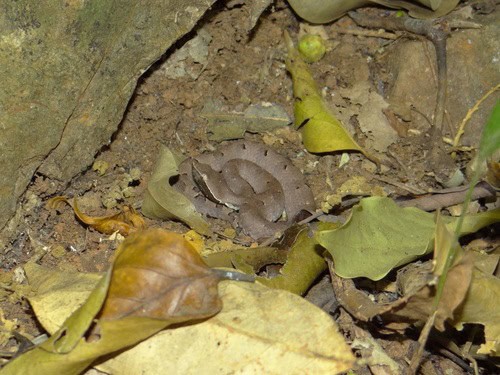
The Hypnale viper genus now contains three species. Hump-nosed pitvipers are the only member found in India. They also occur on Sri Lanka, where the remaining two inhabit, both of which are endemic to Sri Lanka. These are the Sri Lankan hump-nosed pitviper (Hypnale nepa) and the lowlands hump-nosed pitviper (Hypnale zara).
Hypnale hypnale only appears on Sri Lanka below 600 metres. H. nepa only appears in highlands above 1250 metres, while H. zara is restricted to a portion of rainforest in Sri Lanka’s southwest.
A 2012 study from Sri Lanka sought to find differences between them. Hypnale hypnale caused the most bites at 93, followed by H. nepa (16) and H. zara (5). Interestingly, there was a huge difference in location. Most Hypnale hypnale bites happened in backgardens, H. zara struck its victims in forests, while H. nepa bites occurred in tea plantations. Across the three species, most bites occurred during daytime.
| 9 | More bite statistics |
The Sri Lankan study also gave us more data on symptoms, to compliment the Indian data. None of the 114 victims received antivenom, so these are the “raw” symptoms. Swelling affected 86% of Hypnale hynale patients, and in 10.8% this spread more than halfway down the limb. Blisters erupted in 10.8%, and spontaneous bruising affected 22.6%. As for nastier symptoms, 12.9% of Hypnale hypnale victims experienced necrosis, the death and sloughing off of healthy tissue.
The most common systemic symptoms were headache and nausea, both at 14.0%. This was followed by fever (10.8%), vomiting (9.7%), and abdominal pain (5.4%). One patient (1.1%) experienced acute kidney injury, and no deaths were recorded.
Compared to an Indian cobra, this species is much easier to overlook. Three factors combine to keep it out of sight: a smaller size, supreme camouflage, and tendency to hide in leaf litter beds. The unluckiest victims have even experienced strokes, possibly due to metalloproteases degrading blood vessel walls within the brains. The Sri Lankan members have killed victims within 30 minutes due to cardiac arrest.
| 10 | Common in unexpected places |
The Indian team from earlier conducted another study in the western Ghats mountains, this time comparing the 3 native pitvipers. Hump-nosed pitvipers were the most common of the three, accounting for 46.63% of pitviper sightings. Bamboo pitvipers came second at 28.09%, followed by Malabar pitvipers at 25.28%.
However, their abundance varied wildly by area. In Bondla Wildlife Sanctuary, no hump-nosed pitvipers were observed at all. They were strangely missing, for unexplained reasons. In Bhagwan Mahaveer Wildlife Sanctuary and National Park, they outnumbered the bamboo and Malabar pitvipers fourfold each.
This species’ venom varies by region too. For example, venom samples taken from southern Sri Lanka had nearly twice the necrotising activity as those from the western Ghats. Simultaneously, the Sri Lankan venom had haemorrhagic activity nearly 1.5 times weaker. Another study found that venom samples from southwest Sri Lanka had significantly weaker necrotising and haemorrhagic activity compared to the western Ghats, and the rest of Sri Lanka. There’s variety even by micro region with hump-nosed pitvipers. One specific forest could contain the pitvipers from hell, while another could be surprisingly survivable.
